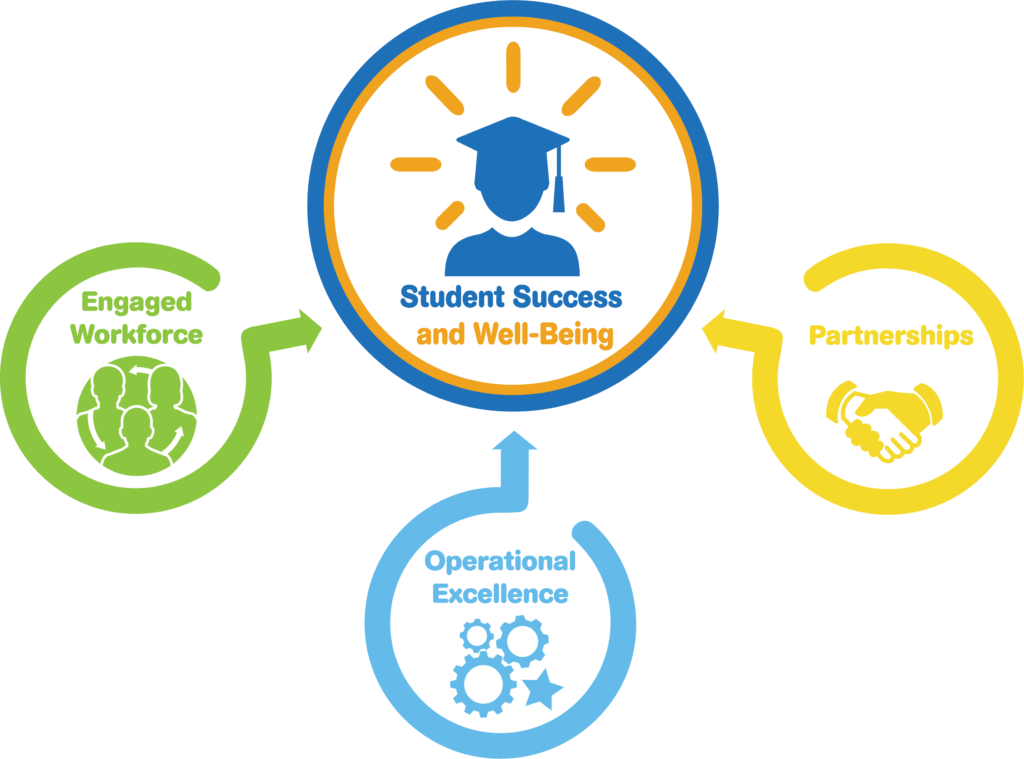MISSION
To ensure all students learn and thrive in safe, healthy, and supportive learning environments
VISION
To be an inclusive community that empowers all students to foster their dreams, explore their possibilities, and create their futures
CORE VALUES – Full Description
Excellence : Equity : Inclusivity : Integrity : Collaboration : Innovation : Stewardship
GOALS
Student Success : Student Well-Being : Engaged Workforce : Operational Excellence : Partnerships
BACKGROUND INFORMATION
APS policy, the adopted Strategic Plan, and the Code of Virginia require that Arlington Public School review and update the strategic plan periodically. This is done to ensure it remains a high-quality guiding document as the division and the world around us changes. APS calls that process “tuning”.
The APS Strategic Plan for 2022-28 has two levels.
- The first level is the foundations of the Strategic Plan, the Mission, Vision, Core Values, and Goals. The foundations were developed in collaboration with the community and were adopted by the Board in June, 2018. Refinement of the Strategic Plan foundations occurs every six years and will include input from a variety of stakeholders including staff and the community.
- The second level is the implementation and monitoring of the plan which consists of the Strategies and Performance Objectives. The implementation and monitoring elements were developed by staff and were adopted by the Board in October, 2018 and tuned in February, 2022.
Note that each of these processes extends the Strategic Plan to provide a six-year horizon at the conclusion of the process. Accordingly, the tuning process that occurred in 2022 extended the Strategic Plan to 2028. The next tuning process will occur during the 2023-24 school year and will go into effect July 1, 2024.
-
 Student Success
Student SuccessEnsure that every student is challenged and engaged while providing multiple pathways for student success by broadening opportunities, building support systems, and eliminating barriers. APS will eliminate opportunity gaps so all students achieve excellence.
Description
- All students are academically challenged
- Access to personalized learning opportunities
- Multiple pathways to graduation
- Engagement in activities that reflect college and career opportunities and provide the opportunity to learn about and
experience workplace expectations and career options - Access to all curriculum, options schools, and programs without barriers
Performance Objectives
- By 2024, APS will reduce opportunity gaps for all reporting groups on state assessments. (PO-SS-1)
- By 2024, all elementary and middle school students will annually demonstrate growth by a minimum of one level using district assessments and students performing at the advanced level will continue to perform at the advanced level. (PO-SS-2)
Strategies
- Embed the 5Cs (critical thinking, creative thinking, collaboration, communication, and citizenship skills) into curriculum and instruction. (S-SS-1)
- Deliver curriculum through innovative and relevant instruction that is differentiated to meet the diverse needs of e/strategic-plan-strategies/#S-SS-1ach student. (S-SS-2)
- Provide learning opportunities in a variety of settings, times, and formats that include opportunities for students to align knowledge, skills, and personal interests with career and higher educational opportunities including internships and externships. (S-SS-3)
- Address unconscious racial bias by implementing implicit bias training throughout APS. (S-SS-4)
Desired Outcomes
- Students achieve at the level of their peers, irrespective of race, ethnicity, gender, home or native language, disability, special learning needs, economic background, or other factors that should not be predictors of success. (O-SS-1)
- Students master the foundational skills of reading, writing, and mathematics. (O-SS-2)
- Students achieve or exceed standards on proficiency and readiness assessments by grade level and subject area (reading, writing, mathematics, science, and social studies). (O-SS-3)
- Students have equitable access and opportunity across all school programs. (O-SS-4)
- Students experience at least one level of growth each year. (O-SS-5)
- Students apply critical thinking, problem-solving skills, and creativity in all subject areas. (O-SS-6)
- Students earn passing scores on AP and IB exams. (O-SS-7)
- Students participate in internships. (O-SS-8)
- Students earn dual-enrollment college credits. (O-SS-9)
Additional Data
- End of Year Assessments– Results on student achievement on standardized assessments including Standards of Learning tests in English, mathematics, science, and history. (VDOE School Quality Profiles)
- College and Career Readiness – Results on the preparedness of graduates including the types of diplomas earned by students, graduation rates, students participating in advanced programs, students earning career and technical certifications and industry licenses, and postsecondary enrollment. (VDOE School Quality Profiles)
- Student Growth in Reading and Math – Results on students passing state tests and non-passing students who are making significant progress toward passing. (VDOE School Quality Profiles)
- SAT Scores – Results on APS students scores on the Scholastic Achievement Test (WABE Guide) (Open the file for the year of interest and click on SAT Scores in the index.)
- Special Education – Results for Special Education students including graduation, dropouts, assessments, suspension/expulsion, least restrictive environment, and parental involvement. (VDOE Special Education Performance Report)
-
 Student Well-Being
Student Well-BeingCreate an environment that fosters the growth of the whole child. APS will nurture all students’ intellectual, physical, mental, and social-emotional growth in healthy, safe, and supportive learning environments.
Description
- Our learning environment is physically and emotionally safe for students and adults
- Prevention and intervention services for physical, mental, behavioral, and social-emotional health
- Engagement in healthy practices that can be continued throughout life
Performance Objectives
- Disproportionally in suspension rates by race/ethnicity, students identified with a disability, and English Learners will be annually reduced and overall suspensions will not increase. (PO-SWB-1)
- By 2024, at least 80% of students with disabilities will spend 80% or more of their school day in a general education setting. (PO-SWB-2)
- Key findings on the Your Voice Matters survey will show improvements in student social, emotional, and mental Health. (PO-SWB-3)
Strategies
- Integrate culturally relevant concepts and practices into all levels of school interactions. (S-SWB-1)
- Establish and promote a culture of physical, social, emotional, and mental health wellness. (S-SWB-2)
- Implement an evidence-based curriculum that focuses on students’ physical, social, emotional, and mental health needs. (S-SWB-3)
- Ensure all students can identify at least one school-based adult who supports and encourages their academic and personal growth. (S-SWB-4)
- Establish systematic, proactive, and positive strategies, interventions, and Restorative Justice practices that support student learning and well-being in all areas involving student conduct. (S-SWB-5)
- Increase co-taught sections of courses and classes to support the inclusion of students. (S-SWB-6)
Desired Outcomes
- Students feel supported by the adults in their school and trust the adults to assist them on their successful educational journey. (O-SWB-1)
- Suspensions disproportionality for high-risk populations are reduced. (O-SWB-2)
- Overall suspensions do not rise. (O-SWB-3)
- Increase the general education LRE percentage to reflect students with disabilities participation in general education. (O-SWB-4)
- Students learn health and wellness practices and have opportunities necessary to develop lifelong healthy habits, including opportunities for physical activity and healthy food choices. (O-SWB-5)
- Students are mentally healthy. (O-SWB-6)
- Students are socially healthy. (O-SWB-7)
- Students and parents report that learning environments are safe and conducive to learning. (O-SWB-8)
- Students feel valued and respected. (O-SWB-9)
- Students understand and work with people from different cultural and language backgrounds. (O-SWB-10)
- Students make personal connections to the curriculum and materials. (O-SWB-11)
Additional Data
- Student Perspectives on Health and Well-Being – Results for student perception of safety, health, support, engagement, and voice. (Your Voice Matters Survey)
- Healthy Behaviors – Results for health-related behaviors that contribute to the leading causes of death and disability among youth and adults such as violence, STDs, alcohol and other drug use, tobacco use, unhealthy dietary behaviors, and inadequate physical activity. (Youth Risk Behavior Survey – Arlington County)
- Special Education – Results for Special Education students including graduation, dropouts, assessments, suspension/expulsion, least restrictive environment, and parental involvement. (VDOE Special Education Performance Report)
- School Climate – Results for student safety. (Safe Schools Information Resource)
-
 Engaged Workforce
Engaged WorkforceRecruit, hire, and invest in a high-quality and diverse workforce to ensure APS is the place where talented individuals choose to work.
Description
- Strong recruitment and hiring as well as strong staff retention
- Evaluation processes provide actionable feedback for all staff
- Employees are included, respected, and supported
- Information is readily accessible to all staff in order for them to do their jobs effectively
- Visionary leadership is demonstrated while supporting high expectations that balance the needs of all stakeholders
Performance Objectives
- By 2024, at least 70% of APS staff will respond favorably that opportunities for professional learning meet their needs, as indicated on the Your Voice Matters survey. (PO-EW-1)
- By 2024, APS staff will respond at the 75th percentile or better on staff engagement and climate, as indicated by the Your Voice Matters survey. (PO-EW-2)
- By 2024, all staff participate in training that meets or exceeds industry standards for their position. (PO-EW-3)
Strategies
- Recruit, retain, and advance high-quality employees. (S-EW-1)
- Provide growth opportunities by implementing a competency-based professional learning and evaluation framework inclusive of all staff members. (S-EW-2)
- Grow and develop current and future high-quality leader/managers. (S-EW-3)
- Develop integrated approaches that promote employee health and wellness. (S-EW-4)
- Establish intentional and focused recruitment and retention efforts to bolster a diverse workforce. (S-EW-5)
- Ensure leader/managers have access to high-quality workforce data.(S-EW-6)
Desired Outcomes
- APS staff are healthy. (O-EW-1)
- The APS employee diversity profile reflects the Arlington resident diversity profile.(O-EW-2)
- The APS teacher diversity profile reflects the student diversity profile.(O-EW-3)
- Staff experience a positive work climate.(O-EW-4)
- Staff are positively engaged in their job and in their work location.(O-EW-5)
- Staff participate in PL supporting certification requirements for their position.(O-EW-6)
- Staff participate in PL aligned with the divisions’ competency needs.(O-EW-7)
- Employees have the skills to move into leadership positions. (O-EW-8)
- Staff participate in meaningful PL aligned with their personal growth needs.(O-EW-9)
Additional Data
- Teacher Quality – Results for teacher capability and capacity including student-teacher ratios in grades K-7, student-teacher ratios in grades 8-12, teacher educational attainment, provisionally licensed teachers, and the percentage of classes in schools, school divisions and the state taught by teachers not fully certified in the content area. (VDOE School Quality Profiles)
- Staff Perspectives on Workplace Environment – Results for staff perceptions on the APS workplace environment including engagement, health, safety, support, and voice. (Your Voice Matters Survey)
- Salaries – Comparisons of APS to local school division salaries for Teachers, Instructional Assistants, Bus Drivers, and School Board Members. (WABE Guide) (Open the file for the year of interest and click on desired Salaries link in the index.)
-
 Operational Excellence
Operational ExcellenceStrengthen and improve system-wide operations to meet the needs of Arlington’s growing and changing community.
Description
- Resources are aligned with needs
- Technology is leveraged to support learning and administrative needs
- Facilities are designed, developed, and maintained for high-performance learning and working environments
- Environmental stewardship practices are in place
- Data-based decision-making leads to continuous improvement
Performance Objectives
- PO-Organizational operations will continuously improve their effectiveness as measured by identified KPIs. (PO-OE-1)
Strategies
- Manage available resources equitably. (S-OE-1)
- Provide high-performance learning and working environments that support Universal Design for Learning standards. (S-OE-2)
- Identify and redesign or eliminate inefficient services. (S-OE-3)
- Use long-term and systematic processes to ensure academics and operations are financially sustainable. (S-OE-4)
- Systematically improve the quality of organizational operations. (S-OE-5)
Desired Outcomes
- School supports are allocated based on the needs of the student population. (O-OE-1)
- Facilities are upgraded and maintained equitably. (O-OE-2)
- Resources are used efficiently. (O-OE-3)
- Operational services show high financial return on investment. (O-OE-4)
- Academic services show high student outcome return on investment. (O-OE-5)
- Budget projections show financial sustainability. (O-OE-6)
- Operations meet requirements. (O-OE-7)
Additional Data
- Accreditation – Results for Virginia state accreditation ratings and information on high school graduation. (VDOE School Quality Profiles)
- Finance – Results on fiscal responsibility including the percentage of expenditures for instruction, per-pupil spending (state comparison), and sources of financial support for operations. (VDOE School Quality Profiles)
- Learning Environment – Results for operational factors that can have a major impact on school quality and student performance such as attendance, absenteeism, safety, discipline practices, and whether eligible students are participating in school breakfast and lunch programs. (VDOE School Quality Profiles)
- Class Size – Comparisons of APS class size to local school divisions. (WABE Guide) (Open the file for the year of interest and click on Average Class Size in the index.)
- Per-Pupil Cost – Comparisons of APS per-pupil cost to local school divisions. (WABE Guide) (Open the file for the year of interest and click on Cost Per Pupil in the index.)
- School-Based Positions – Comparisons of APS school-based positions to local school divisions. (WABE Guide) (Open the file for the year of interest and click on Cost Per Pupil in the index.)
-
 Family Partnerships
Family PartnershipsDevelop and support strong connections among schools, families, and the community to broaden opportunities for student learning, development, and growth.
Description
- High-impact strategies for engaging all families
- Technology is leveraged to support learning and administrative needs
- Facilities are designed, developed, and maintained for high-performance learning and working environments
- APS programs and services integrate with those in the broader community
- Community businesses and organizations provide opportunities for internships/externships, service, and leadership
development
Performance Objectives
- By 2024, at least 90% of APS families will respond favorably on student and family engagement on the Your Voice Matters survey results. (PO-P-1)
Strategies
- Provide training and resources for staff and families to create meaningful partnerships that support student success and well-being. (S-P-1)
- Partner with local, state, and national businesses, organizations, and governments to support a variety of learning experiences. (S-P-2)
- Partner with advisory committees, nonprofits, and other local organizations to strengthen engagement with all families and provide wrap-around services to students including healthcare, nutrition, academic, and social and emotional supports. (S-P-3)
- Build a comprehensive structure for defining strategic partnerships, setting expectations, monitoring performance, and measuring quality. (S-P-4)
Desired Outcomes
- O-P-1: Intentionally Omitted
- School and program family engagement events build the capacity of staff and/or families in capabilities, connections, cognition, and confidence in families. (O-P-2)
- All schools are welcoming to our diverse families and provide varied opportunities for engaging parents as equal partners. (O-P-3)
- All essential information is easily accessible to diverse families on multiple platforms and in the top five languages. (O-P-4)
Additional Data
- School Readiness – Results for student Kindergarten readiness. (VDOE School Quality Profiles)
- Partnerships: School Climate – Results for family perception of how they are treated by APS staff. (Your Voice Matters Survey)
- Partnerships: Home and Community – Results for family perception of student participation in activities. (Your Voice Matters Survey)
- Partnerships: Family Engagement – Results for family perception of their engagement with school. (Your Voice Matters Survey)
Core Values
Excellence: Ensure all students receive an exemplary education that is academically challenging and meets their social and emotional needs.
Equity: Eliminate opportunity gaps and achieve excellence by providing access to schools, resources, and learning opportunities according to each student’s unique needs.
Inclusivity: Strengthen our community by valuing people for who they are, nurturing our diversity, and embracing the contributions of all students, families, and staff.
Integrity: Build trust by acting honestly, openly, ethically, and respectfully.
Collaboration: Foster partnerships with families, community, and staff to support the success of our students.
Innovation: Engage in forward-thinking to identify bold ideas that enable us to be responsive to the expectations of our organization and community while cultivating creativity, critical thinking, and resourcefulness in our students.
Stewardship: Manage our resources to honor the community’s investment in our schools; create safe, healthy, and environmentally sustainable learning environments; support civic and community engagement; and serve current and future generations.
 Contact
Contact  Calendars
Calendars Careers
Careers Engage
Engage  District
District
